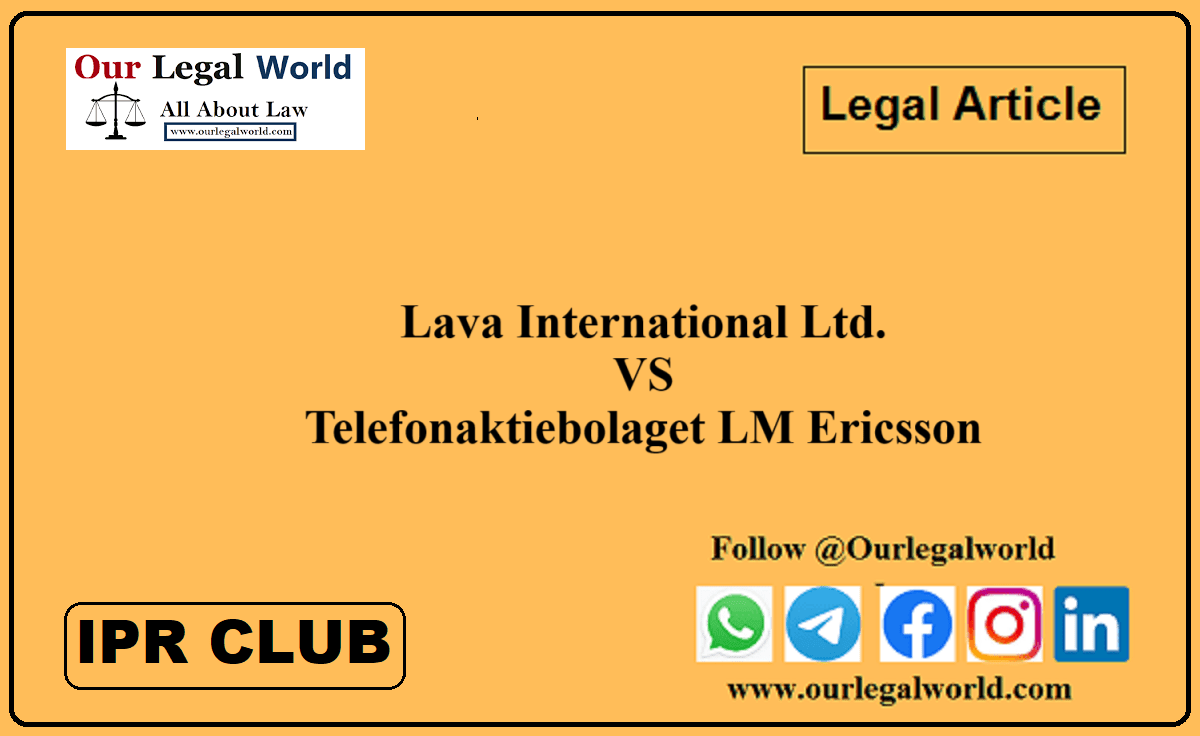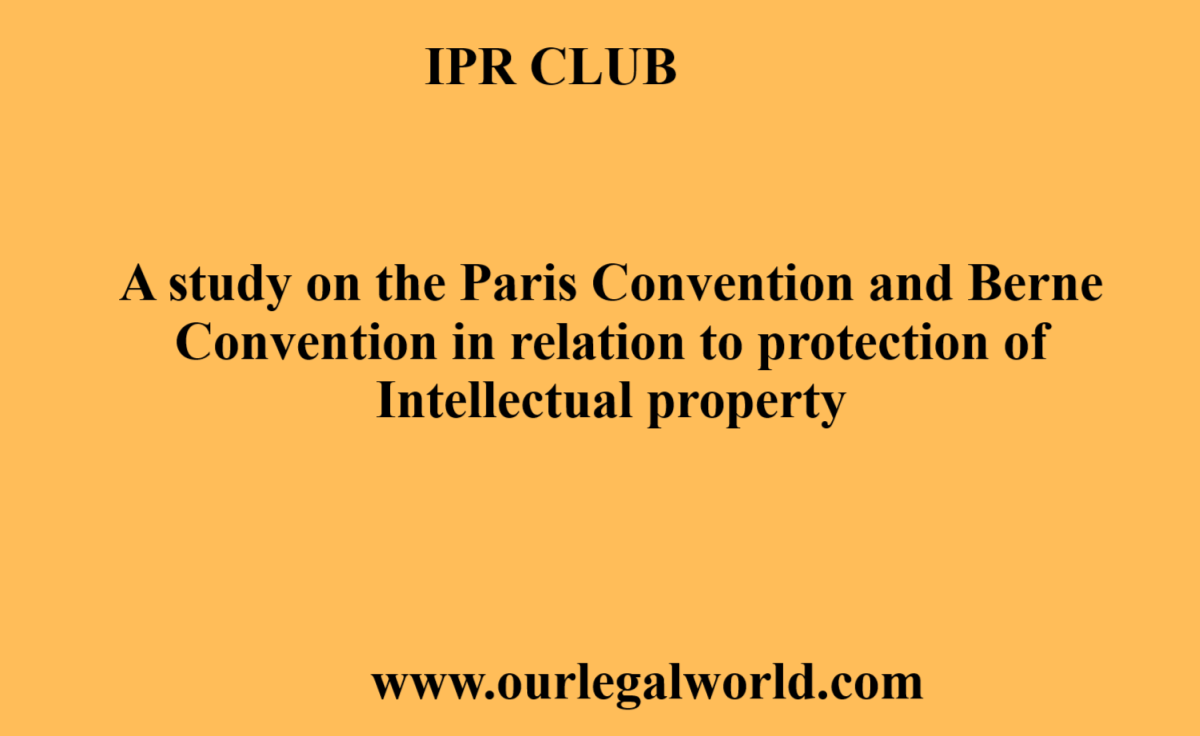Lava International Ltd. v. Telefonaktiebolaget LM Ericsson
Written by KRITIKA THAKUR, 3rd year {National Law University, Delhi}
Abstract
The instant case[1] is a landmark judgment in the sphere of Intellectual Property Law in India, reinforcing the importance and value of SEPs, and the fact that the need that first gave rise to FRAND obligations for SEP holders is still pressing. This case walks the fine line between overprotecting creativity at the cost of trade and stifling intellectual innovation for a short term gain in the market. The analysis undertaken in this piece will focus on the intersection of these concepts and intellectual property law in India, and will also explore the implications of this decision for the landscape of patent and licensing in the technology industry as it relates to intellectual property law. Finally, this analysis hopes to examine the limitations and challenges faced by this sector in India.
Also Read: Novozymes vs Assistant Controller of Patents
Introduction
Standard Essential Patents, or SEPs, are crucial to the telecommunications sector for two important reasons that also make them unique among patents: they ensure interoperability, and allow innovation. The instant case involves, at its core, a dispute over exactly these SEPs, and in dealing with issues of patent validity and infringement, the court has examined the responsibilities of SEP holders under the FRAND licensing terms. There are 3 questions examined by the court in this case:
- Validity of Patents
- SEP infringement
- Fulfilment of FRAND obligations
In the rapidly developing technological space, this case ensures a balance between innovation and fair and free access.
This case seems to take its cues from the Supreme Court’s analysis[2] in Novartis AG v. Union of India, where the court clarified that the purpose of patents is not to stifle innovation, but rather to encourage it without limiting competition. This is drawn upon in the court’s ruling, requiring that patents must comply with the novelty rule and also contribute to technological advancement.
This analysis will explore these questions and their implications in detail in the subsequent sections.
Legal Background
The core issue in the instant case is Ericsson’s claim that Lava’s use of their SEPs was unlawful, because it didn’t have the required license, while Lava in turn challenged the validity of the patents in question, contending that under the Indian Patents Act, they are non patentable algorithms.
SEPs facilitate seamless interoperability between different manufacturers, necessitating guidelines like FRAND to prevent misuse. FRAND obligations exist mainly to prevent the abuse of the SEP holder’s market position, and ensure fair terms in contracts. The instant case is therefore significant not only to the contending parties but also to the telecommunications industry at large, especially with regard to patents.
The court in this judgment has aligned itself with foreign jurisprudence in insisting that FRAND terms must be mutually beneficial for both parties, fostering interoperability and innovation[3].
Legal Questions in the field of IP Law
As mentioned above, the 3 key questions in the case are those of Patent Validity, Standard Essential Patents (SEPs), and FRAND obligations.
For a patent to be valid, certain requirements must first be met, such as novelty, an inventive step (non obviousness), and industrial applicability. Under section 3(k), however, algorithms are non patentable, which is what Lava contended Ericsson had done, since there was allegedly no inventive step in their work. Ericsson, of course, maintained that theirs was a valid SEP, crucial in the telecommunications industry. The primary concern here was whether Ericsson’s patent was valid, and this question had several nuances that might not be immediately obvious to the uninitiated that the court explored.
Here we must note the judgment cited by the court, Core Wireless Licensing SARL v. Apple Inc.[4] The court in that judgment had also affirmed the standards of patentability, and there also novelty or innovation and industrial applicability were included.
SEPs are patents for complying with certain mobile communication standards, such as 2G, 3G, or 4G. These patents must be licensed to others in order to ensure interoperability. The key arguments on this point revolved around whether or not Ericsson’s patents met the standard of being “essential” to compliance with industry standards.
The court’s analysis of SEPs mirrors the analysis carried out in the case of ZTE v. Huawei[5], where it was found that delaying obligations could not be used to avoid licensing obligations. Lava’s “bad faith” was their use of similar stalling tactics.
Finally, the question of FRAND Obligations. This was, at least in its conception, a simple issue of compliance- whether or not Ericsson had fulfilled its FRAND obligations, with Lava claiming it had not, and Ericsson claiming bad faith negotiation on the part of Lava.
Here also the court draws from the Unwired Planet v. Huawei, where the two way nature of FRAND obligations was emphasized. Here, as in ZTE v. Huawei[6], Lava exhibits unreasonable demands in order to hold out on fair negotiations.
Court’s Analysis and Decision
The court in this case held that Ericsson’s patent met the requirements of validity and also that they were in fact essential to the telecommunications standards in question, and represented the kind of genuine innovations and forward-looking movement that is so valued in patenting, holding that the patents in question were not even obvious to those skilled in the field, and that they had a specific application, satisfying the industrial applicability requirement. To the point specific to being SEPs, the court found that alternative technologies would not suffice for the purpose, and as such, to use these SEPs without proper licensing, as Lava had done, amounts to infringement.
The court’s finding here aligns with the decision in Nokia Technologies OY v. Guangdong Oppo[7], where essential patents were required to be licensed in order to comply with standards. Drawing on this decision, the court held, as stated above, that Lava had infringed upon Ericsson’s SEP.
In terms of the FRAND obligations, the court once again found in Ericsson’s favour, finding that the terms offered by Ericsson were both fair and reasonable by industry standards, and that it had not offered discriminatory terms, since the terms offered to Lava were the same terms offered to other companies. Lava had not negotiated in good faith, evident from the negotiation process itself- Lava had stalled the process, made unreasonable and wild demands, and even refused to negotiate at all. The court felt that this evinced Lava’s disinterest in actually gaining a license, and implied an intent to use the technology without proper licensing.
The court thus granted Ericsson relief for the infringement in the form of damages and an injunction against Lava.
Implications for IP Law
This case reinforces the importance and validity of SEPs in India, and emphasizes their value to technological interoperability and innovation. Thus, SEP holders are likely to find their positions strengthened, and this will likely have implications for future negotiations and strategies, along with future industry practices, especially in industries like telecommunications.
The court also provided clarity on what constitutes compliance with FRAND obligations, and placed much needed emphasis on the reciprocal nature of these obligations in the context of negotiations- they are not a burden placed solely in order to handicap the SEP holders, but also set a standard for the implementers of the SEPs in question, requiring them to avoid infringement through good faith contracting.
The decision in this case leans into innovation and its fostering in the technological space, providing inventors the assurance that their work will remain protected even as fair dissemination of innovative solutions is promoted. Thus the court strikes the fine balance between protecting Intellectual Property Rights and fostering creativity in technology.
One potential challenge that might stem from this decision is the power imbalance this might cause in negotiations between large SEP holders and smaller companies. The fact that these are essential technologies already gives the SEP holder an edge in the negotiation process, and this only reinforces that edge. This might even encourage SEP holders to engage in aggressive licensing practices by leveraging the precedent set by this judgment.
Another issue that might emerge is ambiguity in FRAND obligations. This judgment reinforces their importance, but does not actually provide objective standards against which to measure otherwise subjective values like “fairness”. This issue
Finally, this might lead to an increase in patenting thickets, leading to mired licensing mazes, and discouraging market entry for smaller players. Patent thickets are, simply put, a large number of overlapping patents in a very small field. This slows the market down, since both innovation and trade has a complicated navigation process that must occur before any real progress is made, reducing competition as well as innovation.
Still, these are only speculations, and the good done by this judgment might well outweigh the potential issues to arise from it.
Conclusion
By recognizing the essentiality of the Patents held by Ericsson and also insisting upon good faith negotiations in contracting for SEPs, the court has, perhaps counterintuitively, encouraged such negotiations by affirming the safety of SEP holders and allowing them to fearlessly enter into such negotiations in the first place, loading the dice in favour of mutually beneficial trade and contractual engagement. This case also provides clarity on how to apply IP law and its principles to emerging technology, and striking crucial balances between free trade and protecting intellectual property. Courts will continue to play a central role in how rules and practices in the intersection of intellectual property law and technology evolve, but as this sector advances, this decision will remain a guide to structuring licensing and SEP practices in the future, and will become a foundational influence upon the way the interplay between public interest and intellectual property rights is handled.
[1] Lava International Ltd v Telefonaktiebolaget LM Ericsson (CS(COMM) 65/2016) [2024] High Court of Delhi
[2] Novartis AG v Union of India (2013) 6 SCC 1
[3] Unwired Planet International Ltd v Huawei Technologies Co Ltd [2020] UKSC 37, [2021] AC 255.
[4] Core Wireless Licensing SARL v Apple Inc 899 F.3d 1356 (Fed. Cir. 2018)
[5] Huawei Technologies Co Ltd v ZTE Corp (C-170/13) [2015] ECLI:EU:C:2015:477
[6] Ibid
[7] Nokia Technologies OY v Guangdong Oppo Mobile Telecommunications Corp Ltd [2021] EWHC 2952 (Pat)





![Jamia Hamdard Mediation Competition 2025 at School of Law, HILSR [21st February 2025]](https://www.ourlegalworld.com/wp-content/uploads/2024/12/Screenshot-11-min-1.png)

